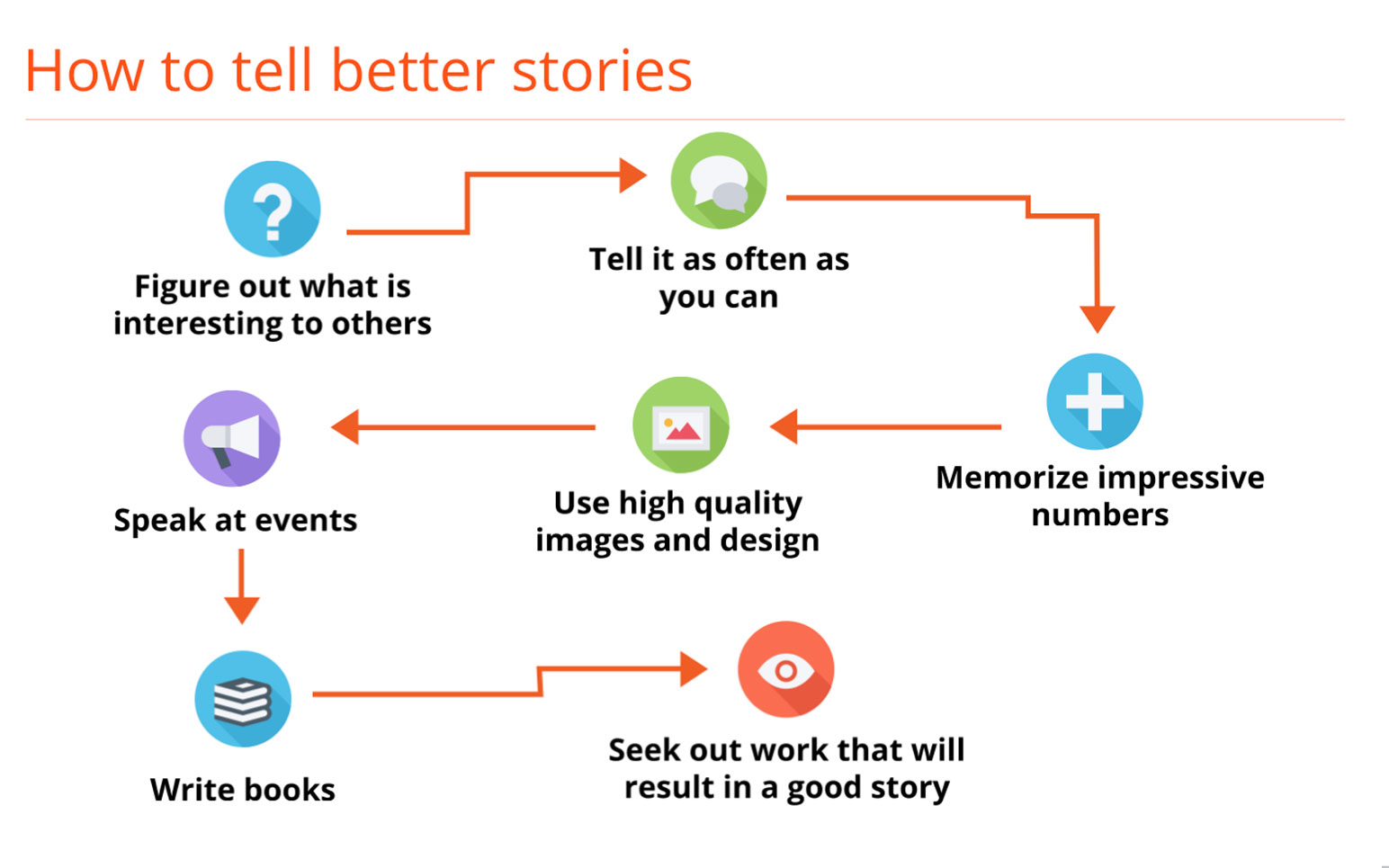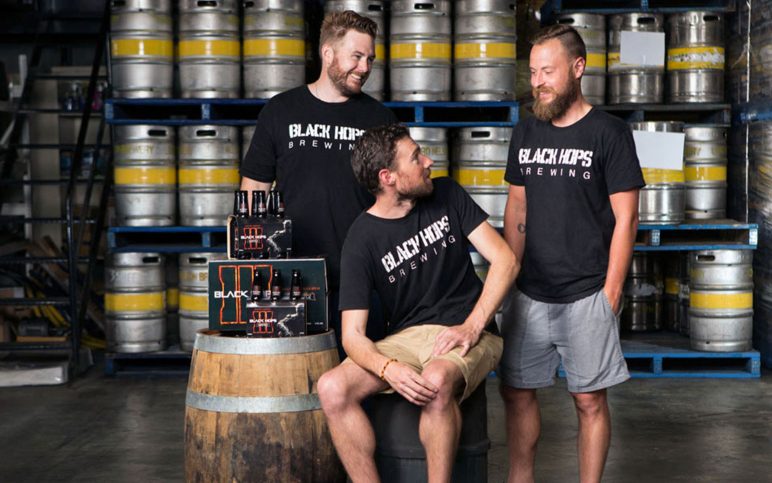Storytelling in business: how to use it to grow your brand
Storytelling has forever been a core piece in the way humans communicate. It’s universal and powerful, and as marketers, it’s something that is at the core of our skillset. Still, storytelling in business wasn’t something I really thought about too much when I was starting out. I heard it mentioned a lot, but I never really read anything very practical about how to do it. I figured it was a bit of a wanky buzzword and moved on to other sensible marketing strategies like yellow pages ads.
I did, however, start telling my story naturally. I enjoyed writing about my journey and I got good feedback from others. But I didn’t realize how powerful it was as a way to spread the message. I also didn’t really know exactly how to do it, or more importantly how not to do it.
That was until Kyle, who worked for me at the time, noticed a striking similarity between my income report and the story arc of Cinderella.
This is my wage that I was using to tell my story in my monthly reports at the time.
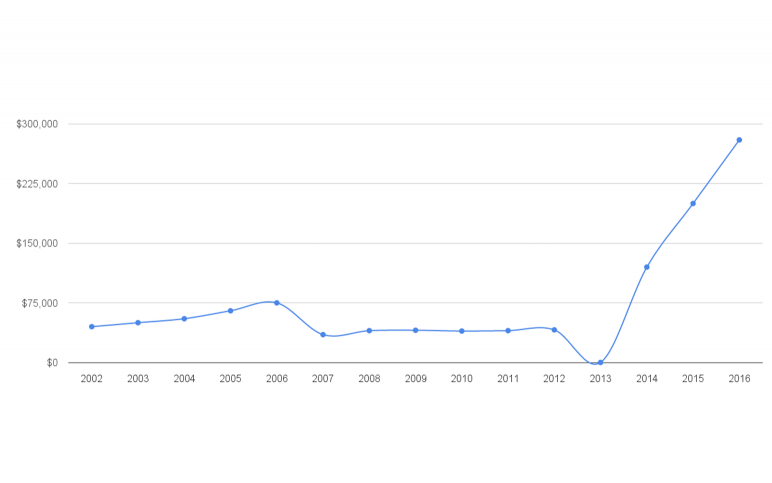
This is the story arc of Cindarella that Kyle came across.

It got me thinking. What I was doing all along was telling a universal story about my journey (without knowing it). Once I realized, I used this knowledge to tell stories about a bunch of other projects I worked on, with great success.
Universal storylines
In his book ‘The Seven Basic Plots: Why We Tell Stories’, Christopher Booker contends that any story will only ever consist of one, or a combination of, 7 basic plots: Overcoming the monster, rags to riches, the quest, voyage and return, comedy, tragedy and re-birth. A few of these are particularly powerful for businesses.
- Overcoming the monster – This is the classic David vs Goliath storyline and is used in business often. Check out Apple’s 1984 ad introducing the Macintosh and directly attacking the bigger company IBM.
Steve Jobs said this, before introducing the ad “It is now 1984. It appears IBM wants it all. Apple is perceived to be the only hope to offer IBM a run for its money. Dealers initially welcoming IBM with open arms now fear an IBM dominated and controlled future. They are increasingly turning back to Apple as the only force that can ensure their future freedom. IBM wants it all and is aiming its guns on its last obstacle to industry control: Apple. Will Big Blue dominate the entire computer industry? The entire information age? Was George Orwell right about 1984?”. Dude could sell!
- Rags to riches – Everyone loves a good rags to riches story. A lot of famous businesses and entrepreneurs draw on this storyline to spread their message (Howard Shultz, Oprah, Richard Branson, or Ray Krok as portrayed in the recent movie The Founder). This story works particularly well if you can show a story of someone who goes from rags to riches, then back to rags, then back to riches. Everyone loves a comeback.
- The quest – This storyline follows someone who is on a mission to achieve something (i.e. launch a successful business). We’ve seen this in startups with transparent income reports and posts about the things they are learning along the way. The Groove blog is a good example. Gimlet, the best storytellers in the world of podcasting, use this to follow founders as they launch their companies. Their latest series follows former American Apparel founder Dov Charney as he attempts to launch a new company after being fired by American Apparel. Throw in some controversy and you have a very engaging story.
- Rebirth – During the course of the story, an important event forces the main character to change their ways, often making them a better person. Think Steve Jobs being fired by Apple and triumphantly returning after experiencing a lot of hard years. Elon Musk has a similar story after being fired by PayPal. It’s no wonder these stories are the ones that make the books and movies.
These stories make great podcasts, books and movies but they also make great sales material and great press opportunities. Get your story right and you’ll have access to free attention that marketing dollars can’t buy.
If you have ever seen Daniel from Thankyou Group tell his story, you will recognize all of these elements masterfully woven into his presentation. A David vs Goliath struggle against bully competitors shutting him out of supermarkets, a rags to riches to rags then back to riches story of constant failure and re-birth, a trip to an impoverished country where he returned a different person, ready to take on earth’s biggest challenges. You name it, The Thankyou Group story includes it all. I had to follow him as a keynote speaker at Problogger this year which was a bit daunting, particularly since he’s also the world’s best speaker.
You may not be able to cover all of these off, but you can use bits of them in different parts of your marketing. I’ve used stories like these in a number of ways from books to website copy to presentations and press stories. In the rest of this post, I’ll focus on how to get the most out of your stories using this model I put together for the talk I gave after “World’s best speaker Daniel” at Problogger.
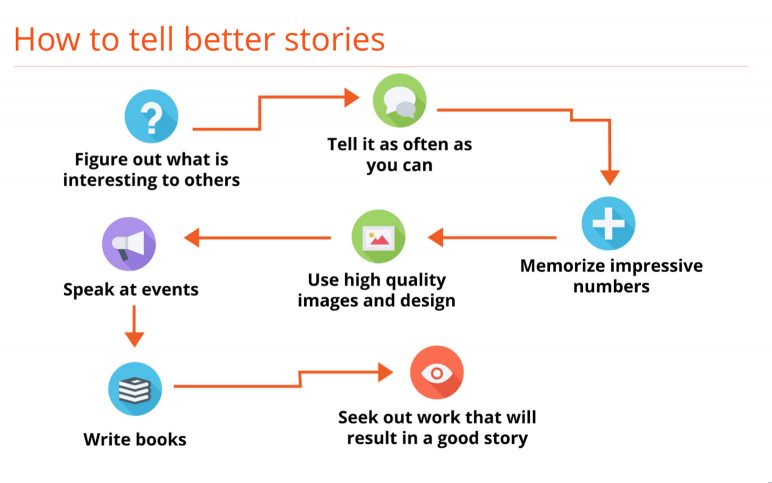
Note: I’ve added one more to the end since delivering the talk, more on that later.
Figure out what is interesting to others
One of the hardest things to get past with storytelling is yourself. It’s far too easy to tell the story you want to hear and assume everyone else wants the same thing. But time and time again I’ve been wrong on this. You have to think about who is reading the story, not who is telling it.
With my brewery Black Hops, for example, we often get press when we brew interesting beers. For example, when we brewed our Oyster Stout for a competition, we made it into the paper. For us, it wasn’t that weird (it’s a recognized style), but to casual newspaper readers the idea of drinking a beer brewed with Oysters is a bit crazy and therefore it was a great press opportunity.
Awards are similar, when companies win awards, industry insiders will know which awards are legit and which aren’t. But for the most part, the media won’t know, they just want a good story. It’s often mentioned in my intros that I was voted Australia’s best business blogger in 2012, by Smarter Business Ideas magazine. I’m not sure people knew much about the award, but it sounds legit! (I didn’t mention that I told people I’d give them free beer if they voted for me).
To tell a good story you have to understand who you are telling the story to, and get out of your own head.
Here are some ways to do it:
- Come across as down to earth and ‘on the level’, not above people – no one likes a wanker.
- Talk about things that people can empathize with or relate to. This helps build rapport and ultimately trust. In entrepreneurship circles, everyone can relate to failure, so I’m not afraid to talk about it often. Stories like the one below (How many times should I try), always grip entrepreneurs, because they have come up against much more failure than the average person.
- Incorporate universal storylines like overcoming the monster, rags to riches, the quest, rebirth and interesting hooks like controversy, contrarian, surprise or fear.
- Incorporate humor if you can. People love to laugh and love people that make them laugh. Self-deprecation can be an endearing quality in storytelling but you have to be careful not to overdo it.
- Be as transparent as you can possibly be. Try not to sugar coat the negatives or failures. They’re all part of your story and add to your tapestry. People will respect and trust you more.
- Be consistent in your message always. If you’re contradicting yourself, people will see through you pretty quickly, and any legitimacy you may have had will disappear.
Tell your story as often as you can
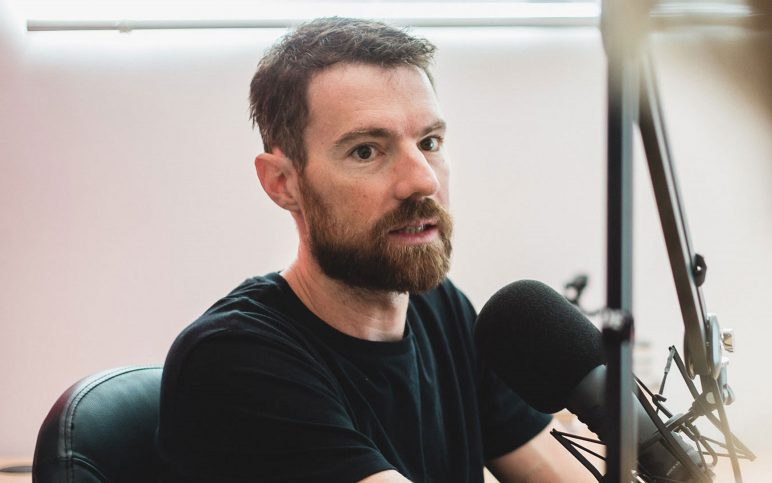
Growing your brand or business using storytelling won’t happen overnight, so know your story and tell it often. Map it out, practice it, and take every opportunity to share it and deliver the key messages consistently. This feels weird at first because you hear it so much. But remember point 1 above – it’s not about you. I love this quote by French author André Gide which I included in my book Create or Hate.
Everything that needs to be said has already been said. But since no one was listening, everything must be said again.
I’ll tell my story, or abbreviated versions of it, across a variety of platforms at every chance I get. I’ve done so many podcast interviews that I’ve lost count. Usually, an element of my story will be woven into them, even if the topic of discussion is more business focussed. The same goes with my public speaking engagements. I also use my story in press opportunities and have woven my story into my 4 self-published books.

As I’ve already mentioned, I’m a big advocate for being transparent and talking about the tough parts of my journey as well as the successes. I used to share my income reports, even when there was no income to report! People would tell me not to be so honest, but being this open has proved to work in my favor.
Effective storytelling creates trust and builds an engaged audience who want to hear more. So why wouldn’t you tell it as often as possible? In saying that, I don’t want to give the impression that you should be strutting around talking about yourself 24/7. Remember what I said about wankers?
Telling your story often is more about taking opportunities to share your highs and lows in a natural way that is valuable to the context in which you are telling it.
Memorize impressive numbers
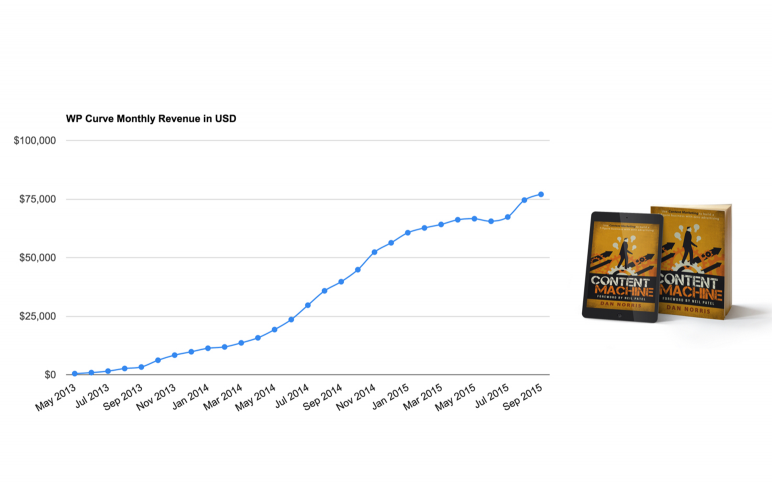
People and particularly press outlets love numbers. Most people only read headlines so anything that can be communicated at light speed is a good thing to include. Here are a few thing I try to include when I get press and in my bio. If the press see these numbers, they will be more likely to do a story.
- The word ‘Million dollar business’. A business doing $900,000 in revenue isn’t that interesting. But a business doing $1m is far more interesting.
- The number of social media followers is something the press often report on. You might have the worst engagement on earth but if you have 500,000 followers on Instagram I would be mentioning that at every opportunity to get press (not that I advocate paying attention to these vanity metrics when making your own decisions).
- I included the number 7 in my first book The 7 Day Startup. It’s an impressive number if we are talking about building a business and the idea has a long history of working universally in business.
- When I talk about my books I always mention them being ordered more than 50,000 times and being translated into 10 languages. It sounds impressive and it makes it a better story.
People are busy, and immersed in noise, giving them anything memorable will help and people remember numbers. If there’s any numbers in your business story, add them into your copy and your bio and mention them when you get the chance.
Same goes for a chart or a graph. If you have some key metrics or numbers related to your business that add value to your story or brand, know them and share them at the right times. If you can communicate something quickly with a graph, go for it.
Use high quality images and design
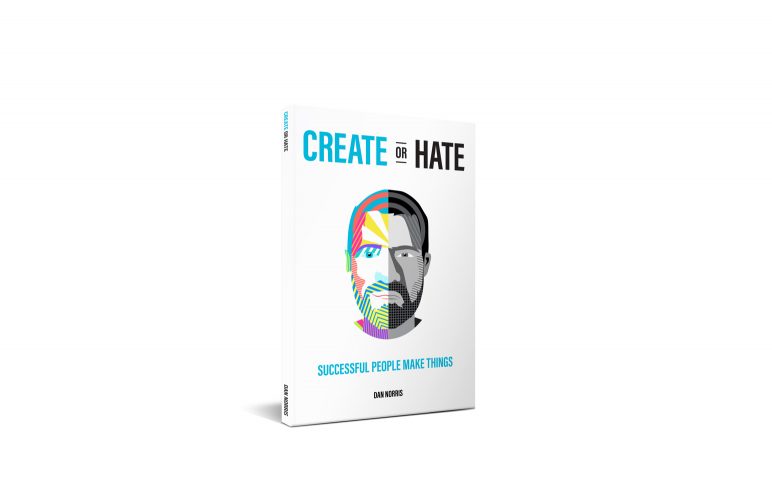
While it’s important to have a great story, the way that you present it, from the images you use to the design aspects of your website and your logos and branding, also play a big part in how people react to your message. One really simple hack for this is making sure you have epic photos. Quite often I’ve noticed when a bunch of people are included in a story, the story will either be written around the person with the best photos or it will at least feature more of their photos, or larger photos.
Again it’s about telling your story as quickly as possible. It’s hard to explain to someone that you are legitimate but it’s very easy to show them (and just as easy to show them that you aren’t).
It’s no good having an epic story if your design support material makes you look like a shoddy amateur.
I feel that a lot of entrepreneurs don’t give this enough attention.
To represent yourself and/or your business in the best light, make sure that all supporting images and design aspects are of the highest quality.
Related: Design 101 for entrepreneurs
Speak At Events

Speaking at events is another great way to get your story out there to a new and captive live audience. You may be speaking about an entirely different topic, but weaving in aspects of your story/journey is a great rapport builder. People will listen to you and trust you a whole lot more if they resonate with you first and foremost as a person. Telling your story at events gives you the chance to do this.
I’ve had some entrepreneurs tell me they don’t see the ROI of speaking at events because it’s not scaleable. I don’t think they realize how much impact you can have in person when it comes to telling stories.
I know that getting up and talking in front of an audience is not everyone’s cup of tea. It took me over 10 years to overcome my aversion to it. I even wrote a blog post about it. But if you do get public speaking opportunities and have the courage to take them on, treat it as an opportunity to build an engaged audience who identify with you and want to hear more..by listening to your stories. You can legitimately acquire lifelong fans by speaking in person.
To steal a line from my previous blog post: “Speaking to 100 people in a room could result in more legitimate connections than writing a post for 10,000 people online.”
Write Books
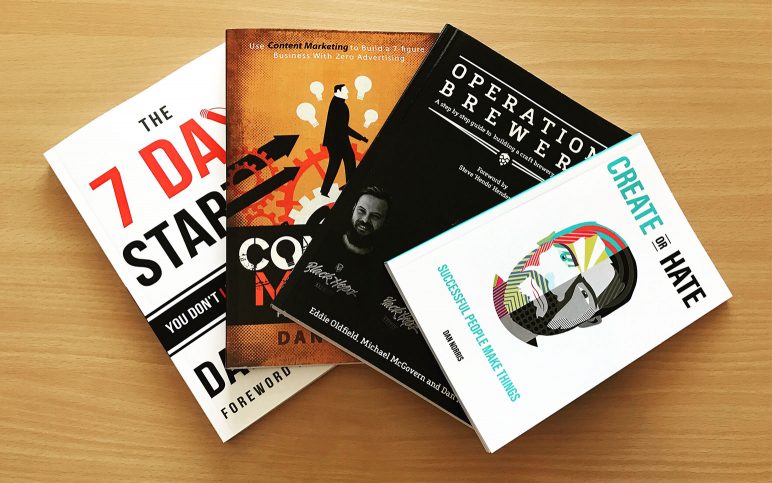
When people think of stories and storytelling, most people think of books. If you can deliver your story or elements of it, via the published word you’ll be taking your credibility to a whole new level of legitimacy.
Many people are daunted by the thought of what it takes to write a book. I don’t think it’s as hard as people think and regular readers of my blog will know that I’ve self-published 4 best sellers. This post tells you exactly how I did it.
My books aren’t specifically about the story of me and my journey, but I always take the opportunity to weave personal experiences and anecdotes into them. Focus on the interesting, memorable and humorous aspects of your journey and bring them up in a way that adds to the flow of the book, rather than as an afterthought. People will trust and relate to you more if they feel they have an insight into what makes you tick and how you got to where you are.
Related: How to build a six figure side business by self publishing books
Seek out work that will result in a good story
Having a good story to tell is a whole lot easier if the work that you embrace has a bit of a ‘wow’ factor about it. People will naturally be interested in what you have to say and will seek you out to share it. Conversely, it’s ten times harder to get someone to listen to your story if your subject matter is old hat or boring.
People love the fact that I’m a brewery owner as well as a content marketer. And it’s provided me with countless opportunities to tell my story, not because I’m pushing it out there onto people but because people want to hear it.
The entire Black Hops journey has been about taking opportunities and doing things outside the norm. This has resulted in a whole heap of interesting stories that we’ve used to generate press and public interest. We get to tell our story because we’re going about things in a way that people want to hear about. Our audience appreciates our 100% transparency and our willingness to embrace new challenges. By sharing our story through podcasts, blogs and speaking in person, we create interest that leads to more interesting opportunities. One big happy circle! The once in a lifetime opportunity to brew the world’s first Call Of Duty beer would never have come about if we weren’t creating a buzz and generating interest in our journey from the very beginning. And we took it on not to make money, but because we knew it would be a great story and we would get a lot of attention.
Don’t give away the ending
Now, remember I said I’d explain a common mistake of storytelling right at the start of this post? I said that so you’d keep reading. If I told you everything in the first sentence you wouldn’t read the post. This is the mistake.
I went to an event recently, where 2 entrepreneurs told their story of how they grew their business. One tracked a line chart through failure, more failure and then a big turning point and a huge hockey stick shaped growth curve. He revealed it bit by bit so we didn’t know what was coming. When he revealed each section the crowd gasped – it was impressive stuff.
The other entrepreneur had an even more powerful story. He had built a business in 18 months that was doing $800,000 USD / month. His presentation was very similar to the first one however on the first slide of his presentation, that showed even before he got on stage, it said “0 to $800,000 / month in 18 months”. The highest impact in his presentation happened before he even made it to the stage. One small tweak to the story and it would have been the best presentation of the event.
I reveal my story slowly when I talk about it. I show people my annual wage in a job and for my first 7 years of being an entrepreneur:
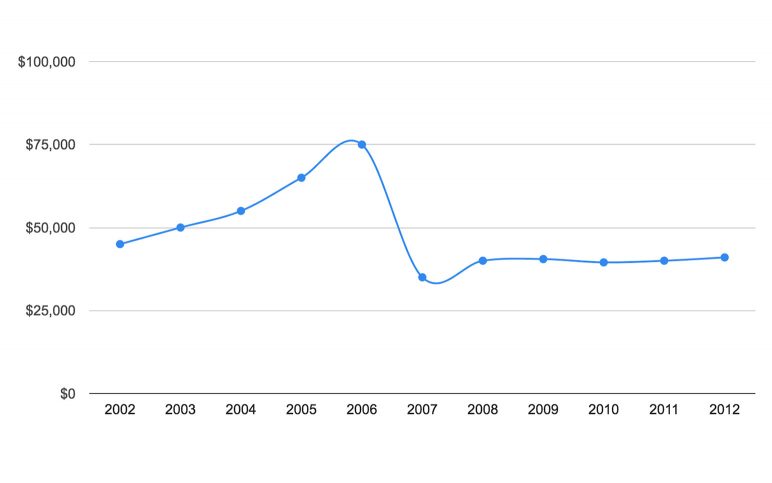
Then I tell them of my plans to ditch my shitty business and build an epic world-class software startup and chase hockey stick growth, then I show them the results:

Then I explain my desperation at coming up with a silly business idea that everyone told me was terrible. Then I show them the results:

You can save telling your story with the ending first for hollywood directors. For everyone else, it’s much more impactful to reveal it slowly and save the best for last.
I believe that everyone has it in them to tell a good story, so I hope that this post has given you a better insight into how you can make storytelling work better for you. If you want to share your thoughts on this topic, feel free to use the comments below.
And if you’re not already a member of my email group, jump onboard here. If you want to chat about business and online marketing more, join my in my free Facebook group here. We passed 10,000 members las week (see what I did there?).
